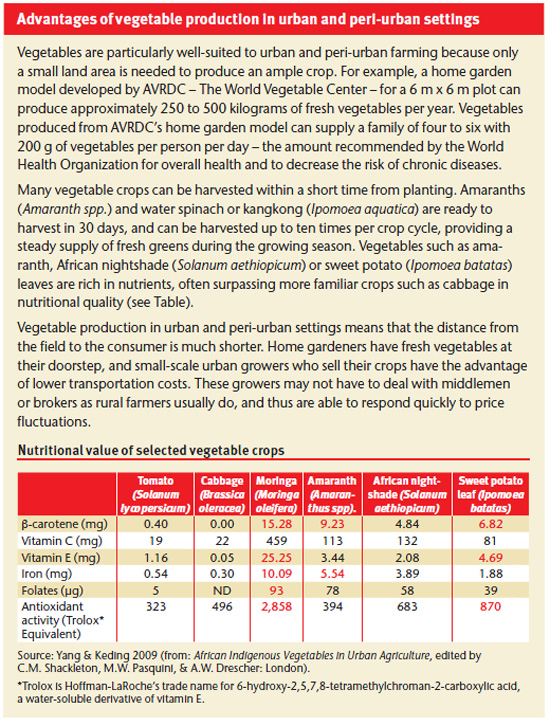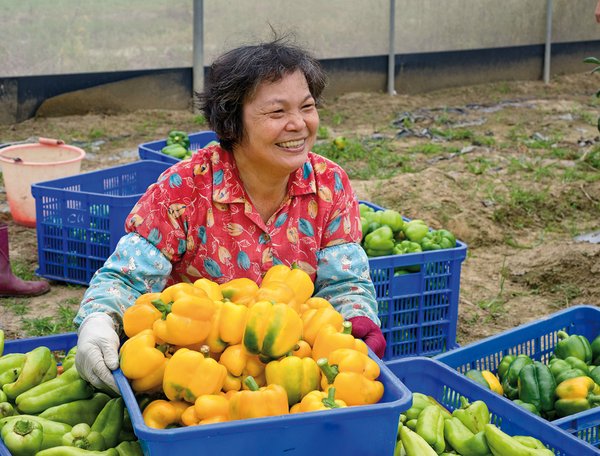 Download this article in magazine layout
Download this article in magazine layout
- Share this article
- Subscribe to our newsletter
Handling fresh vegetable produce from urban gardens
Due to high levels of unemployment in cities, many families depend on growing their own produce, especially vegetables, on small plots for home consumption and for sale. Poorer families spend a larger proportion of their income on food. Thus the ability to grow their own vegetables contributes significantly to household food and income security. Nutrition security is enhanced as well; vegetables diversify diets and, more importantly, are a source of micronutrients, vitamins and minerals vital for good health (see Box at the end of the article).
AVRDC – The World Vegetable Center – develops and promotes a range of vegetables, from tropical tomatoes to traditional leafy crops, which can be grown in urban and peri-urban environments. Simple, low-cost methods to handle these valuable crops after the harvest can help urban and peri-urban vegetable growers reduce post-harvest losses and provide more and better quality vegetables at home and to local markets.
Post-harvest problems
Vegetable quality needs to be maintained from the moment of harvest. Even when the distance from the farm gate to the consumer is relatively short, as in urban and often in peri-urban horticulture, growers must take care when harvesting, storing, packing and transporting fresh produce to prevent damage and maintain quality. Harvested vegetables release heat from respiration and lose moisture, which detracts from their appearance and weight. A study conducted in Rwanda on amaranths packed for the market showed they had eleven per cent weight loss within half an hour, while in Benin, 89 per cent of the leafy greens that were packed for the wholesale market had mechanical damage (see: ucce.ucdavis.edu/files/datastore/234-1848.pdf). Leafy vegetables have a large surface area over which they lose a lot of moisture; even a five per cent loss will result in visible wilting. Not only do bruised, damaged, or over-mature vegetables appear unattractive and fetch lower prices on the market, they are also less nutritious. Poor handling and storage methods cause the nutrients in vegetables to deteriorate rapidly.
Water quality is another concern for vegetable production in urban settings. The source of water used to produce and clean the crop may be polluted by industrial and domestic waste. If pesticides are used on crops, pesticide residue may contaminate produce, and the local water supply, if producers are not adequately trained and willing to follow proper use of the chemicals. Growers should avoid using polluted water to wash vegetables after harvest to prevent contamination from microorganisms, pesticide residues and heavy metals harmful to human health. Urban producers need a good understanding of the risks of using contaminated water. Simple solutions such as taking the produce to be cleaned at a site where the quality of water is not in doubt may be necessary.
Simple techniques, big effects
By following post-harvest handling methods best suited to their situations, urban and peri-urban vegetable growers can harvest and deliver produce of good quality to the point of sale. Technologies for resource-poor vegetable growers are available, and AVRDC continues to develop and improve recommendations for growers in urban, peri-urban and rural environments.
The first step to deliver a good-quality crop to the market is to harvest at the optimum stage of maturity. Leafy vegetables should be harvested when they reach full size and before they start losing color and becoming fibrous. Tomato is ready to harvest when its fruit is physiologically mature – that is, when the pink or red color first becomes noticeable on the fruit. Vegetables destined for the market should be graded to remove damaged or diseased material (which will also reduce spoilage) and packed into uniform lots so that they are attractive to consumers and fetch a higher price.
A simple way to reduce post-harvest losses is to harvest before temperatures are high, such as in the early morning or late afternoon, and to keep produce in the shade once it has been harvested. Leafy vegetables kept in the shade will maintain their quality longer than those exposed to full sun. Ice can reduce the temperature of harvested vegetables. Covering produce with a moist material, such as damp sacking or straw (taking care to keep the vegetables dry), is also effective in reducing the temperature by taking advantage of evaporative cooling principles.
Another simple technique is to use good-quality packaging that will protect the crop after harvest. Many growers put their newly harvested leafy greens in large polyethylene bags; during transport the leaves may be bruised or crushed. Bamboo baskets are not suitable for packing soft fruit vegetables such as tomato because the rough surface may damage the produce. Rigid containers with smooth surfaces reduce crushing, bruising and damage.
Training urban growers in proper handling methods and disseminating information to show the economic benefits of good post-harvest handling can help ensure that more vegetables of better quality reach the market. Recommended techniques and technologies should not be time-consuming to apply or expensive, as the lack of capital is often a major barrier to adoption. Improved post-harvest handling results in a higher quality product which is more nutritious and should fetch a higher price – an important incentive for growers to adopt these techniques.

Jacqueline d’Arros Hughes
jackie.hughes@worldveg.org
Ngoni Nenguwo
ngoni.nenguwo@worldveg.org
AVRDC – The World Vegetable Center
Tainan, Taiwan / Arusha, Tanzania





Add a comment
Be the First to Comment